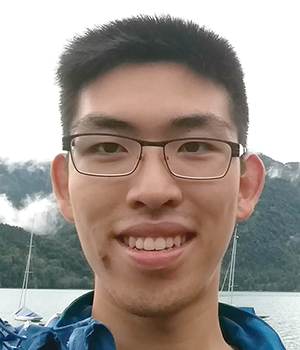Leung ’17 Wins LeRoy Apker Award for Undergrad Physics Work
October 27, 2017
Calvin Leung ’17, a mathematics and physics double major, has become the fourth Harvey Mudd College student to win the LeRoy Apker Award from the American Physical Society for outstanding achievement in physics by an undergraduate. He joins Stephanie Moyerman ’06, Nathaniel Stern ’03 and Gwen (Bell) Porter ’98.
The Apker Award is presented to only two undergraduates nationwide each year—one from an institution that grants PhDs and one from an institution that does not.
“I’m thrilled that this award recognizes Calvin as an extraordinary student and budding scientist,” says Theresa Lynn, chair of the HMC Department of Physics. “In his thesis research, Calvin made important contributions to an international collaboration, but also pursued original applications based on his coursework, prior research experiences and independent perusal of a broad swath of physics literature. It’s wonderful to see fundamental skills and scientific creativity coming together in a senior thesis project, as they did in Calvin’s case and as they do for so many students at Harvey Mudd.”
Leung will be awarded $5,000, and the College’s physics department will receive $5,000 to support undergraduate research in physics.
Leung, who graduated with high distinction and departmental honors in May, received the award for his thesis “Quantum Foundations with Astronomical Photons,” supervised by Jason Gallicchio, assistant professor of physics. The Apker Selection Committee recognized Leung “for development and experimental implementation of astronomical random number generators for loophole-free tests of Bell’s inequality and other applications in quantum fundamentals, astrophysics, and tests of general relativity.”
In this research, Leung played a major role in developing and characterizing an astronomical instrument which uses photons from quasars to generate random bits. The work was motivated by the goal of closing a potential loophole in Earth-based tests of quantum mechanics. These so-called “Bell tests,” named after their discoverer, typically use terrestrially generated random bits to control the measuring devices that observe pairs of entangled particles. In principle, if there were some unidentified interaction that produced the right patterns in these so-called random bits, the kinds of spooky correlations that are a signature of quantum mechanics—and that underlie emerging quantum cryptography technologies—might be explained as much less unique classical phenomena. To rule out this possibility, Leung helped to develop an instrument that uses photons emitted by distant astrophysical processes to generate random bits to use in a Bell test. Because these bits are determined by events occurring thousands or even billions of years ago, they are guaranteed to be causally independent of terrestrial events and thus can provide more convincing tests of quantum nonlocality.
The full experiment was conducted on the rooftops of Vienna in collaboration with researchers at MIT and the Institute for Quantum Optics and Quantum Information-Vienna (IQOQI-Vienna), and improved the bounds on any non-quantum mimicry from milliseconds to hundreds of years. The international collaborators eventually hope to use distant quasars to improve this limit by billions of years, well into the early days of the universe.
This work has led to a publication in Physical Review Letters, a poster at the 2016 Sigma Pi Sigma Quadrennial Physics Conference which won the Optical Society of America’s Best Poster Award, and two additional publications, one in review and another in preparation.
“I was impressed most by Calvin’s creativity and independence,” says Gallicchio, Leung’s thesis supervisor. “He would have an idea, find published papers that pointed to a gap in knowledge that could be filled by his idea and present me with a calculation or plot that showed how we could use the tools we developed to fill this gap. From his theoretical understanding of quantum mechanics and relativity to his optical designs and Python analyses, Calvin took what he learned in classes at Mudd and applied it to address decades-old problems.”
Leung says that he realized the astronomical instrument was capable of performing precise astrophysical tests of general relativity, an idea whose preliminary results were well-received by the Apker Selection Committee and which has blossomed into a research focus for the group at Harvey Mudd.
Calvin is continuing his research in collaboration with colleagues at IQOQI-Vienna while pursuing other investigations in quantum optics. In fall 2018, he will begin his PhD in physics at MIT with a National Defense Science and Engineering Graduate Fellowship.
“I might continue in quantum physics, astrophysics or an entirely different subfield,” says Leung. “From our Cosmic Bell project, I’ve realized that there are so many cool ideas to explore in fundamental physics which draw on multiple subdisciplines. At this point, I just want to learn and not silo myself into any particular corner.”
Leung’s other undergraduate awards include a 2016 Astronaut Scholarship and an NSF Graduate Research Fellowship Honorable Mention. He received the Department of Physics’ Graydon and Louise Bell Prize for Scholarship, Creativity and Service, the Mindlin Prize for Innovative Ideas in Science, and the Alfred B. Focke Award for Outstanding Senior Physics Experimental Research. At Harvey Mudd, Leung tutored first-year and sophomore physics classes for three years, was an Honor Board member, Judiciary Board chair, and an avid unicyclist. Leung is a member of the American Physical Society and the Society for Industrial and Applied Mathematics. In his spare time, he likes to cook and play the cello.
In addition to four Apker Award winners, Harvey Mudd College has had five Apker Award Finalists: Jaron Kent-Dobias ’14, Neal Pisenti ’11, Andrew Higginbotham ’09, Gregory Minton ’08 and Joseph Checkelsky ’04.
